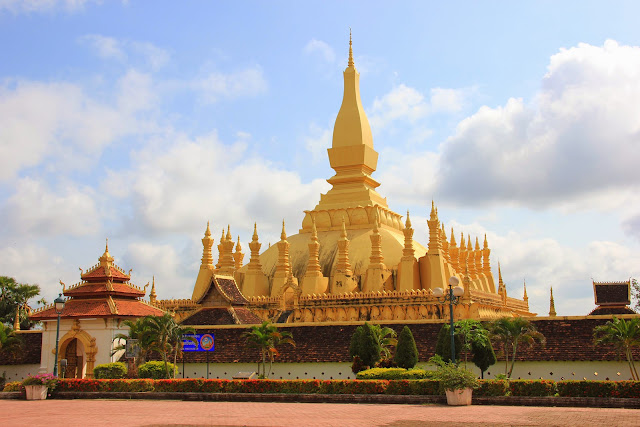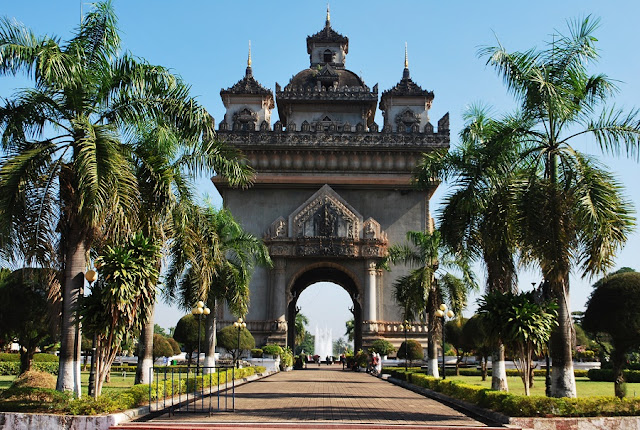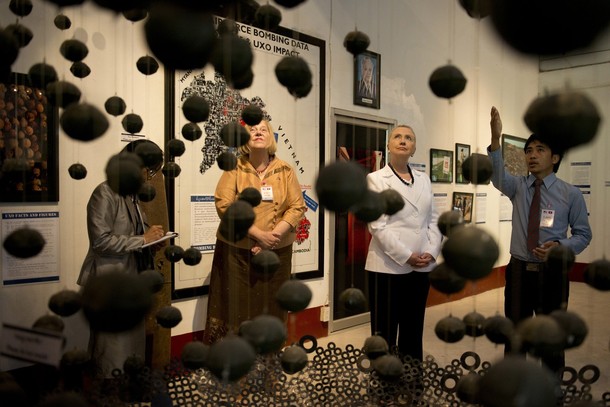1. Buddha park (Xieng Khuan)
Location: Thadeua village, 25km away to the east from central Vientiane.
There is a small fee for entering here as well as for photography.
It was constructed in 1958 by the monk Bounleua with an area of 4 ha. The park is considered as a monumental carved construction with more than 200 Buddha statues of various shapes and sizes made of cement, ancient moss imbued with color of time.
The most prominent statues comprise Indra - the king of Hindu gods riding the three-headed elephant (aka Erawan and Airavata), a four-armed deity sitting on a horse and an artistic god with 12 faces and many hands, each holding weird objects. They are all obviously impressive not only because of their enormous size but because they are full of interesting details and uncanny motifs.
There is also another outstanding sculpture resembling an enormous pumpkin. It has 3 stories representing 3 levels: Hell, Earth and Heaven. Travelers are able to get into it via an opening looking like a mouth of a demon head. Each story contains sculptures depicting its level. Climbing over staircases from hell to heaven will lead to the top, where has a vantage point to see panorama of the whole park.
2. Pha That Luang
Location: at the end of Lan Xang street
Opening time: Monday to Sunday, morning: 8h – 12h, afternoon: 13h – 16h.
This world’s cultural heritage is the symbol of this Buddhism country of thousand elephants. It is the biggest and most beautiful stupa in Laos, built from 1566 on ruins of an Indian pagoda dating back 13th century and inlaid with gold. The That Luang's main tower is embraced by 3 grand layers of wall, decorated with red-lacquered-and-gilded lotus petals and glorious small towers. Surrounding it are green-grass ground along with roofed corridors. In this stupa site, there are 2 small pagodas: Wat That Luang Neua in the north and Wat That Luang Tai in the south.
Before entering this location, travelers if wear short or short skirt will be required to borrow sarong to wrap their leg.
3. Haw Phra Kaew
Location: Setthathirath road
This temple is famous for precious sculpture works, as the most second well-known pagoda in Vientiane only behind Pha That Luang. It was constructed from the 17th to the 18th century by the King Setthathirath when he moved capital from Luang Prabang to Vientiane. Now this site has still saved lots of valued document involving Buddhism. Therefore, it is considered as the national precious thing.
Although Haw Phra Kaew is called as “pagoda”, no monk has ever stayed in it yet. It is surrounded by sophisticated bronze Buddha images.
4. Patuxai triumphal arches
Location: At the end of Lang Xang Avenue in the heart of Vientiane
Patuxai (means: Victory Gate) is the victory symbol of Laotian people. Formerly, it was called as Anousavary (means: memory) and built since 1958. Architecture of the triumphal arches’ bottom and outside was modelled on Arc De Triomphe (Paris, France), but its top and inside showed Laos’ typical architectural features and embossment. From the Patuxai’s highest story, it is easy to observe peaceful rhythm of life of residents in Vientiane capital.
5. COPE Visitor centre
Location: Khouvient street
Laos country has a grievous past because of war; and to learn about that terrible history, travelers should come to COPE Visitor center. Between 1964 and 1973, the American army dropped more than 260 million bombs down to Laos, made it become the top country in the world that incurred the most severe consequences of war. About 30% of these bombs remain unexploded that killed and injured 20,000 people so far. Reaching COPE center, you will feature the history that the Lao underwent. The money donated here has been used to make artificial limbs for victims affected by bombs and mines.
Adventures to Vientiane:









